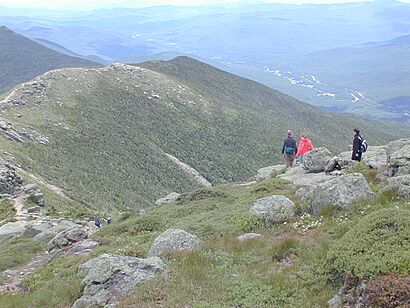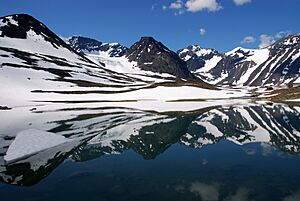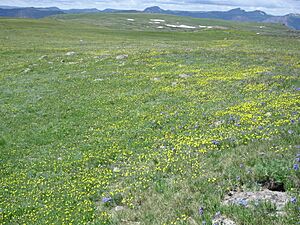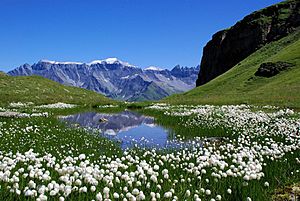Alpine tundra facts for kids


Alpine tundra is a unique natural area, or biome, found high up in mountains around the world. It's a place where trees can't grow because the weather is too cold and windy. This harsh climate is caused by the high elevation.
As you get closer to the Earth's poles, the alpine tundra can be found at lower and lower elevations. Eventually, it can even reach sea level, blending into what's called polar tundra.
The boundary where forests stop growing and alpine tundra begins is called the tree line. Below this line, you might see small, twisted trees known as krummholz. These trees are stunted because they are close to the harsh conditions of the tundra. As you go even higher, the alpine tundra ends at the snow line, where snow and ice stay all year long.
Contents
Where is Alpine Tundra Found?
Alpine tundra exists on tall mountains everywhere, no matter how close they are to the equator. You can find large areas of alpine tundra in many famous mountain ranges.
Some of these include:
- The North American Cordillera (like the Rocky Mountains) and parts of the northern Appalachian Mountains in North America.
- The Alps and Pyrenees in Europe.
- The Himalaya and Karakoram in Asia.
- The Andes in South America.
- The Eastern Rift mountains in Africa.
- The Snowy Mountains in Australia.
- The South Island of New Zealand.
- The Scandinavian Mountains.
Alpine tundra covers mountain tops, slopes, and ridges above the tree line. The exact height of the tree line can change. For example, it's often higher on slopes that face the sun and are warmer. Because it's only on mountains, the landscape is often rocky with peaks, cliffs, and slopes. But you can also find flatter areas.
The tree line generally gets higher as you move closer to the equator. For example, between 30°N and 20°S latitude, the tree line is usually very high, between 3,500 and 4,000 meters (11,500 and 13,000 feet).
What is the Climate Like?
The weather in alpine tundra is called an alpine climate. It gets colder as you go higher up a mountain. This happens because air cools as it rises and expands. For every 100 meters (330 feet) you go up a mountain, the temperature drops by about 1°C (1.8°F). This is similar to moving 80 kilometers (50 miles) closer to the North or South Pole.
Trees cannot survive in the alpine tundra because of the extreme conditions. These include very cold temperatures, deep snow, and often a lack of available water. The growing season for plants is very short, usually only 45 to 90 days long. Even during summer, temperatures often drop below freezing, and frost can happen at any time.
Most of the precipitation (rain and snow) falls as snow in winter. However, how much water is in the soil can vary a lot depending on the season and location. Strong winds are common in alpine areas. They can blow away soil and harm plants. Wind, combined with strong sunlight, can also make plants lose a lot of water very quickly.
How We Measure Alpine Climate

Scientists have tried to define what makes an alpine climate.
A scientist named Wladimir Köppen noticed that the tree line in the Arctic and Antarctic matched places where the average temperature in the warmest month was below 10°C (50°F). This means if the warmest month is colder than 10°C, trees usually can't grow there. You can learn more about this in the Köppen climate classification.
Another scientist, Otto Nordenskjöld, thought that winter conditions also play a role. He created a formula that suggests how warm the warmest month needs to be for trees to survive, based on how cold the coldest month is.
In 1947, a scientist named Holdridge came up with a new idea called biotemperature. This is the average yearly temperature, but any temperatures below 0°C (32°F) are counted as 0°C. This is because plants are dormant (inactive) when it's that cold. If the average biotemperature is between 1.5°C and 3°C (35°F and 37°F), Holdridge classified the climate as alpine.
Alpine Plants

Plants in alpine areas face strong sunlight, wind, cold, snow, and ice. Because of this, they grow very close to the ground. Most are perennial grasses, sedges, and forbs (flowering plants that are not grasses or sedges).
These perennial plants have much more of their mass in their roots and rhizomes (underground stems) than in their leaves and flowers. The roots and rhizomes help them get water and nutrients. They also store food to help the plant survive the winter. Annual plants (which live for only one year) are rare here. They are usually very small with weak roots.
Other common plant types include:
- Prostrate shrubs (shrubs that grow flat along the ground).
- Tussock-forming grasses (grasses that grow in clumps).
- Cushion plants (plants that grow in dense, low mats).
- Cryptogams, like bryophytes (mosses) and lichens.
Alpine regions often have many unique plant species that are not found anywhere else. This high diversity is due to things like geographical isolation (being separated from other areas), climate changes over time, and different ways plants have spread or evolved.
Even though tundra covers only a small part of Earth, the plants found there are very important for human food. Out of the 20 plant species that make up 80% of human food, 7 of them (35%) originally came from tundra regions.
Plants in the alpine environment have special ways to survive. Cushion plants, which look like clumps of moss, stay low to the ground to avoid strong winds. Many flowering plants have thick hairs on their stems and leaves to protect them from wind. Some also have red-colored pigments that can turn sunlight into heat.
Some plants take two or more years to form flower buds. These buds survive the winter underground and then open and produce seeds during the short summer. In some alpine areas, you might see more woody plants starting to grow.
Alpine areas are unique because their conditions are both severe and complex. Even a small change in the land, like a difference of just 30 centimeters (1 foot), can create a totally different environment. One spot might be windy and dry, while another nearby might have deep snow. This leads to a patchwork of different plant communities.
You might find cushion plants on ridges, grasses on slopes, dwarf shrubs near melting snow, and mosses in wet areas.
Alpine meadows form where rocks have weathered down to create good soil for grasses and sedges. Non-flowering lichens cling to rocks and soil. Their tiny algal cells can make food through photosynthesis even when it's just above freezing. The outer fungal layers of lichens can soak up a lot of water.
Even though tundra plants seem tough, they are actually very fragile. Walking on them repeatedly can destroy them, and it can take hundreds of years for the plants and soil to recover.
Alpine Animals

Since alpine tundra is found in many different parts of the world, there isn't one animal species that lives in all alpine tundra areas. However, some animals commonly found in alpine environments include:
- The kea (a parrot from New Zealand).
- Marmots.
- Mountain goats.
- Bighorn sheep.
- Chinchillas.
- The Himalayan tahr.
- Yaks.
- The snow leopard.
- Pikas.
|
See Also
 In Spanish: Pradera alpina para niños
In Spanish: Pradera alpina para niños
- Montane grasslands and shrublands
- Urals montane tundra and taiga
- Polonyna (montane meadow)
- Montane ecosystems
- Tundra




